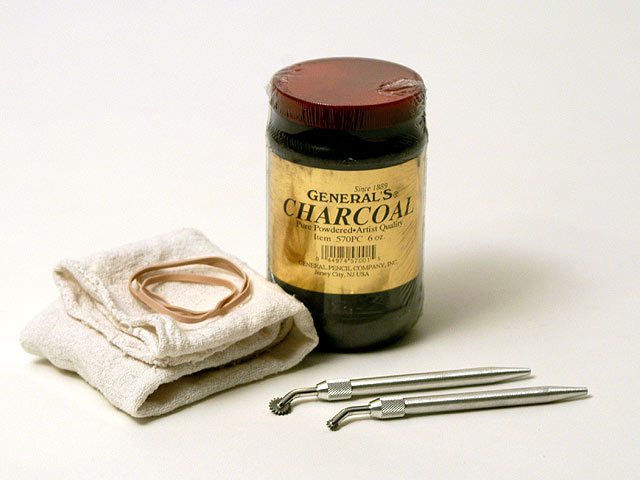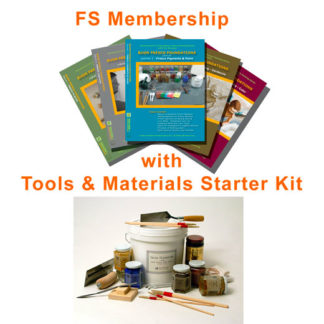Pouncing is an important step in creating a fresco painting. If done properly, you will end up with a clear and distinct “outline” of your traced cartoon on your intonaco plaster. If done incorrectly, you may end up making a mess. The following are some easy to follow tips and guidelines for making a “pounce bag” and proper tracing and pouncing techniques.
Making A Pounce Bag ->
First, you are going to need a cloth that is “porous” enough to let powered charcoal travel through when “tapped”, but no so much that the charcoal pours out of it. Cheesecloth is defiantly out of the question, as is any material that you can actually see through, such as gauze. Even if you use multiple layers of cheesecloth, you’ll still end up with an ugly mess. Powdered charcoal is very fine and it will eventually work itself to the outermost layer… and spill through.
I have found that a simple plain weave, heavy cotton “muslin” cloth is about the most ideal fabric for making a good and sturdy pounce bag. The cloth is similar to the rags used by house painters. Not the thin ones, but the heavier canvas like cloths – just the much softer variety. A 10 or 12 X 12-inch piece is sufficient, but you may want to go a bit larger if you are going to be painting a Sistine Chapel.
Open the cloth completely on a flat surface. Scoop about 2 tablespoons of finely powered charcoal into the center and bring all 4 corners of the cloth together, holding them high but not lifting the “bag” off the surface. Grab hold of the “handle” you just created and tie the ends of cloth together tightly with an elastic band about half to 2/3rd’s the way down between the charcoal “ball” and the top of the cloth. This will leave you enough material to grab onto and create a nice handle. Don’t over-fill… leave some “air space” in the bag. You don’t want a tight ball of charcoal at the end. Give it some room to move around.
Using Your New Pounce Bag ->
The quality of your finished pouncing will depend on two things – the accuracy of your tracing (perforation) and how you “handle” the pounce-bag.
Remember to always make your cartoon tracing “oversized.” Allow at least a few inches on all sides. This will help shield you panel, or giornata, from an ugly “overspray” of charcoal.
Perforating (also referred to as tracing) your traced cartoon should be done carefully and meticulously with a needle sharp tracing wheel. The size of the wheel you use depends on the detail you are perforating. The smaller (1/4 inch) wheels are perfect for getting around tight corners and curved lines. The 7/16-inch wheels are great for less complicated lines. Lay your cartoon on a flat surface over a large sheet of 1/8-inch roll cork and work slowly enough to capture all of the detail that you need to reproduce on your intonaco. Press hard enough to create a series of tiny pinholes but not so hard that you make the holes too large or possibly tear through the paper. You will begin to recognize the “popping” sound of the paper being perforated correctly. As you work, hold the paper up to a light to inspect your progress and to make sure you haven’t missed anything. If you make any mistakes or have torn through the paper, you can easily make repairs with tape. If, on final inspection, by holing it up to a good light source, you find that some of your perforations are “closed”, they can be corrected by a very light “sanding” with a fine sandpaper from the back side.
Now it’s time to make the actual transfer in charcoal ->
Carefully position your tracing over the intonaco. If you are working on a panel, place it upright on an easel so the excess charcoal falls off the tracing. You can tape it in place to the back of the panel but tape the top end only. If you a working on a wall, you will need help from an assistant to hold it in place while it is being pounced.
When pouncing, always start at the bottom and work across the entire sheet. Don’t try to follow your drawing outlines. Continue working upward, from side to side, until the entire cartoon has been pounced. Hold the pounce-bag “handle” with your fingertips and the back of your hand facing the tracing. Use a gentle touch, but firm enough for results. Use a back-hand slapping motion as you swing the bag and “tap, tap, tap” your way up. Remember it’s a methodical tapping motion you are going for, not a whacking. At this point the fresh intonaco is still somewhat soft and you can actually dent its surface. The reason for starting at the bottom is so you can see what you are doing. As you pounce, a lot of charcoal will spill down the tracing. If you start at the top you will cover the un-pounced part of your cartoon with falling charcoal.
A Few Notes On Storage and Safety ->
Store your pounce bag in an unbreakable sealed container such as an old coffee can with a lid. You are going to knock it over. This will just help minimize the clean up. There is almost no fun in having to wipe up a lot of charcoal.
Always exercise care when handling powered charcoal. Avoid breathing dust and do not eat, drink or smoke while handling charcoal or dry pigments. For protection use dusk mask approved for dusts and mists. Wear protective gloves and clothing. Wash your hands immediately after use. Keep these materials out of the reach of children. Do not reuse any containers for food or household items.
Mitchell Nussbaum








